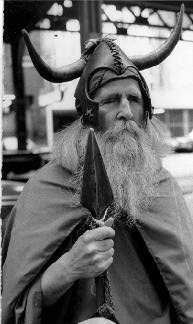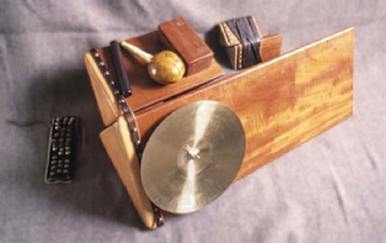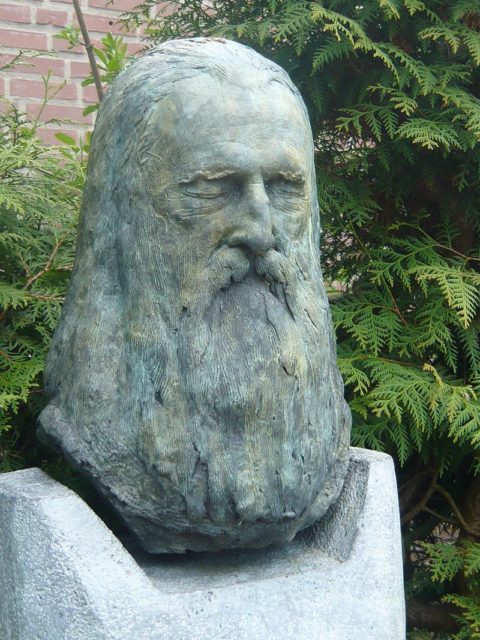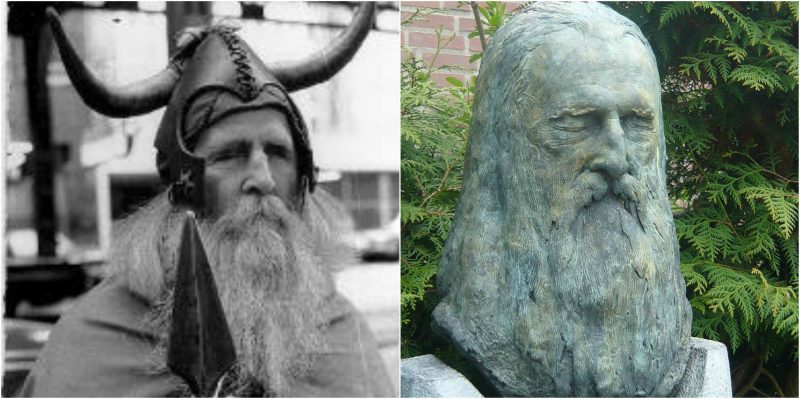Sometimes between the 1940s to the early ’70s, a tall blind man with long hair and beard, wearing a handmade Viking helmet and primitive cloak, wandering across the 6th Avenue was a very familiar sight to New Yorkers.
Louis Thomas Hardin, widely known as “Moondog” and locally known as “the Viking of 6th Avenue” was part of the New York landscape during that time. He usually hung around the corner between Sixth Avenue and 54th Street cops and cabbies knew as Moondog’s Corner. Most of those who passed by him every day weren’t aware of his musical career, but musicians like Leonard Bernstein and Arturo Toscanini had the utmost respect for him.
Moondog was born on May 26, 1916, in Marysville, Kansas as Louis Thomas Hardin and even in his earliest day he showed interest in music. When he was five, he made himself a cardboard drum set which he consistently played. This wouldn’t be the only instrument he made or invented during his life. As a child, Moondog’s family moved a lot, so he lived in many of the Plains states. Once, his father took him to an Arapaho Sun Dance ceremony where he played a tom-tom made from buffalo skin. Percussion instruments always captivated him. This experience would influence him during his career, and he would always return to the native American sound that he came in contact with as a child.

When he was 16, he had an unfortunate accident with a dynamite blasting cap which left him blinded for the rest of his life. Since then, Moondog focused himself on music, literature, history and philosophy and gathered all the knowledge he could by himself. At this time, he developed an interest in Norse mythology and Viking culture, and he changed his name into Moondog, after a beloved howling bulldog from his childhood. He said that that dog used to howl at the moon more than any dog he knew.
Music was Moondog’s greatest love, so he went to several schools for the blind where he learned the basic principles of and he managed to teach himself ear training and composition. In 1942 he got a scholarship to study in Memphis, Tennessee where he learned music theory by using braille books.
Moondog came in New York in 1943, when he was 27, and soon he established himself as one of the city’s eccentric figures. His musical talent was immediately noticed by well-known musicians of the time such as Leonard Bernstein and Arturo Toscanini. At his corner of 54th Street and 6th Avenue in Manhattan, Moondog also met some legendary performers like Charlie Parker and Benny Goodman. Their upbeat sound and their often humorous compositions always inspired him in his creative process.
Hardin (Moondog) lived in New York City from the late 1940s until 1972. During this time he mainly worked as a street musician and poet, selling his records and copies of his poetry and musical philosophy to all of those who passed by his corner.

He got his nickname, “the Viking of 6th Avenue”, because of his distinctive dress code. Moondog was long-bearded a and long-haired, and he often wore a “Viking” cloak and a horned helmet. He claimed that he chose this style because he hated being compared with a monk or with the image of Christ. Because of his fascination with Nordic Mythology, Hardin rejected Christianity in his late twenties.
Moondog’s style was mostly inspired by contemporary jazz and classical music and the sounds of the city (street sounds, such as the subway or a foghorn). He called his musical time “snaketime, ” and he described it as “a slithery rhythm, in times that are not ordinary.” Besides being experimental in his sound, he also invented a few musical instruments of his own: small triangular-shaped harp known as the “oo”; the “trimba,” a triangular percussion instrument, and a few other.
In 1974, Moondog moved to Germany, a country for which he had a high opinion. Here he created hundreds of compositions which he wrote in Braille and were later translated into sheet music by Ilona Sommer, the lady that hosted him and helped him with the copyrights for his music. Moondog spent the rest of his life in Germany, and he only visited the United States once more in 1989.

He was invited by the legendary Philip Glass to conduct the Brooklyn Philharmonic Chamber Orchestra, at the New Music America Festival in Brooklyn. This performance contributed to a renewed interest in the music of Moondog and opened his amazing inner world to the public ears.
Moondog passed away on 8 September 1999 in Münster after a heart failure. He was buried at the Central Cemetery in Münster, and upon his tomb, there is a sculpture made according to his death mask, designed by the artist Ernst Fuchs.
